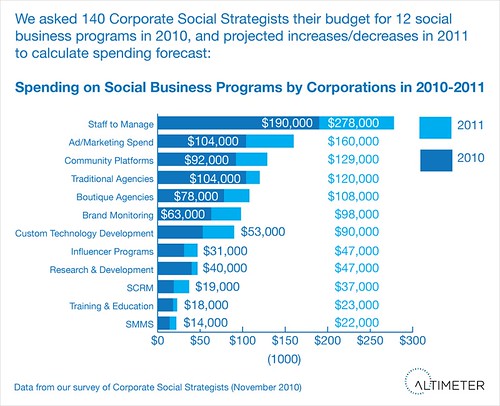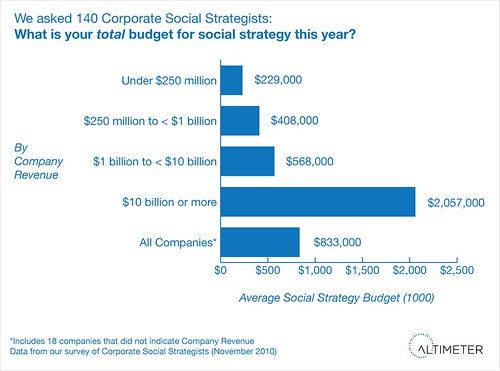Research reveals corporations to focus on integration, staffing, advertising, and measurement in 2011.
I’m sharing these slides as I take the stage for one of the few business focused tracks at the largest European internet conference, LeWeb (pic). The following slides are based on the survey data collected in our latest research report on the Career Path of the Social Strategist which has been downloaded at least 3000 times and viewed over 21,000 times and been discussed on Marketing Profs, RWW, Mashable, Fast Company, and many other blogs. In the deck you’ll recognize some of the data in 2010, but we’ve also segmented it by business maturity.
In the predictions section in 2011, we’ll find data on where companies are going to focus, as well as spending changes based on maturity of corporations –notice how advanced companies shift to customization and social media boutiques.
Above: Here’s a video from the front row (Thanks Erno), apologies, I’m fighting a cold and a bit stuffed up. I added this video later.
Above, here’s the official LeWeb video, thanks Loic
How You Should Invest in 2011: Scalable Programs
1:1 dialog with customers does not scale –you can not hire enough community managers to keep up with the growing number of customer voices, as a result, we recommend that corporations focus on the following six areas of investment for 2011
- Hire correctly (Gurus/Ninjas/Samurai need not apply) and properly train for scale
- Integrate social media on the corporate website, then aggregate and curate
- Invest in advertising that leverages social graph
- Build an unpaid army of advocates get your customers to do the work for you
- Invest in scalable systems like SCRM and SMMS
- Learn to measure using the ROI Pyramid
Open Research: Share it Widely
This data, which we make available for the industry is under the premise of Open Research rather than charging for it. It’s intended for you to use, cite, and share as long as you provide attribution to Altimeter Group. The more you share, the easier it is for us to create more. Some of the select figures are available here on Flickr, embedded below, expect I’ll discuss these in greater detail in coming weeks.

Special thanks to the research team involved in this project lead by Christine Tran, Andrew Jones, and guidance from Charlene Li, all of Altimeter Group, where I’m a partner.



Great preso Jeremiah. Do you have any hard data on what is the size of the SCRM & SMM market?
Like much of the business world, you insist upon grafting a hodge podge of modern organization concepts onto a post-modern and chaotic environment. You ignore the fundamental issue: Folks are racing to social media to escape exactly this type of Harvard Business School “put a yoke on the beast and let it pull the plow” thinking. Fool yourself if you want. But it won't work.
Thanks Jeremiah. Very insightful post, look forward to more data on the overall market.
Thanks for supporting the idea of sharing information that you have worked to understand. It is very helpful to people to question assumptions regarding social business. Sometimes, participants in discussions are not prepared to look at the differences between social media, marketing, networking, and social business. We are just learning how to ask questions.
Sal Rasa
Thanks Jeremiah.
Very userfull post, look forward to more data on the overall market.
It's fits within the Netherlands.
Hi Jeremiah,
I used your presentation when speaking at the CIO East Africa Event (cio.co.ke) dubbed “The Year Ahead” and the feedback was remarkable to say the least. It was a half day event whose audience were the CIO’s from the leading companies in Kenya. I was the last one to speak at the event and the lunch hour chatter was social media and that was a great feeling. I got in touch with the CIO of AAR, the leading health Insurer in this region two days later and he told me that everybody he interacted with was thinking and talking social media after that event and I have of course been asked to partner on future events.
Thanks again for making this an open research. I did not edit it. I just presented it is at is but would explain the local context of where we were in comparison.
Regards,
Marvin